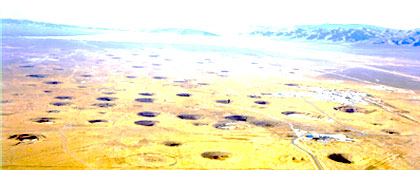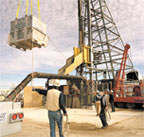 |

WHAT'S GOING ON UNDERGROUND?
Subcritical Testing
At first, the Nevada Test Site looks like an alien landscape, a vast
desert peppered with various sizes of craters. These craters are reminders
of the underground nuclear testing that the United States conducted
at this site until our country stopped all nuclear testing in 1992.
High Pressures using Conventional Explosives
Deep underground—nearly 1,000 feet down, it's a different story and
important experiments are still conducted. It is here that tunnels
and chambers make up what is called the U1a complex, which scientists
use to conduct subcritical experiments. These experiments test the
basic properties of plutonium driven to high pressures using conventional
explosives. These experiments do not generate sustained nuclear chain
reactions and thus do not produce nuclear explosions—that
is what is meant by subcritical.
 To
conduct one type of subcritical test, scientists prepare an experimental
package containing a very small amount of plutonium that has aged for
a certain amount of time. Some distance away is a thin stainless-steel
flyer plate behind which are some high explosives. These materials
are then sealed permanently in a chamber at the end of a tunnel about
1,000 feet below the earth's surface. To
conduct one type of subcritical test, scientists prepare an experimental
package containing a very small amount of plutonium that has aged for
a certain amount of time. Some distance away is a thin stainless-steel
flyer plate behind which are some high explosives. These materials
are then sealed permanently in a chamber at the end of a tunnel about
1,000 feet below the earth's surface.
Once triggered, the explosives slam the plate into the package, sending
shock waves through the plutonium sample. When the waves emerge from
the backside of the sample, light is generated in a special material
that is transmittedalong fiber-optic cables to a series of recording
stations.
Developing the Computer Model
The data collected by these stations help us better understand
how plutonium's aging affects the performance of nuclear weapons and
other weapons materials. Such knowledge will improve the accuracy of
computer simulations, which in turn will help the Laboratory evaluate
weapons reliability and safety without nuclear testing. |

NEVADA TEST SITE
Covering 1,350 square miles, an area larger than Rhode Island,
the Nevada Test Site is one of the largest outdoor laboratories in the United
States.
 From its first aboveground test on January 27, 1951, to the last underground
test on September 23, 1992, the site served as the primary place the United
States conducted nuclear testing. Now the test site is the place where Los Alamos conducts occasional subcritical experiments - nuclear experiments that do not produce self-sustaining nuclear
reactions.
|
